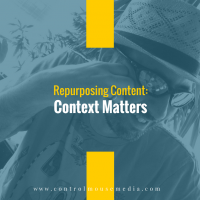Welcome to the third segment in a mini-series about repurposing content. Last week’s episode was Repurposing Content Across Different Formats, where I talked about going from blog to email newsletter, and from podcast (or video) to blog post.
Now, as soon as you start publishing content in more than one channel, you have to start “tuning” your message accordingly. Each channel is its own community, and each has its own norms, language, and cues. You may think of it as one audience, but in reality, it’s a set of unique sub-segments.
The goal of content marketing is to form connections with your audience, so that means that you have to talk to each sub-segment differently.
Marketing is getting highly personalized, and more and more sophisticated. If you’re still speaking to your audience in a generic, blast-it-out-to-everyone way, you’re going to get left behind. This is going to become a requirement in any marketing that you do, if it’s not already.
In this episode, I offer a few of examples how to make practical reuse of content across different contexts, which attending to the subtle differences in each sub-segment of your audience:
- Sales presentations vs. pitch decks
- Letters to customers vs. shareholders
- Press releases vs. blog posts
- Conference presentations vs. YouTube videos
- Using marketing automation with different sub-segments
Listen to the episode here or subscribe in iTunes.
Show Notes
Here is starting point of my 6-part series: Repurposing Content Is a Part of Any Content Strategy.
There’s one more method that I should mention, and that is syndicating content. For instance, publishing a guest blog on someone else’s site – and then syndicating (re-publishing) it on your own blog. This is dangerous for SEO if you don’t do it properly. Here’s how to do it safely: Content Syndication: Safe SEO Practices for Your Blog.
Next week, I’ll get into using my “upstream method” and “downstream method” to either build up or cut apart content for different uses. Subscribe here (and select podcast / every new post) if you’d like to be notified as soon as new episodes are published!
Published by .

